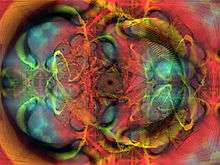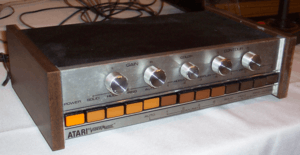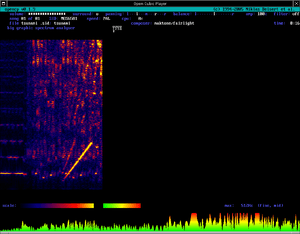Music visualization

Music visualization or music visualisation, a feature found in electronic music visualizers and media player software, generates animated imagery based on a piece of music. The imagery is usually generated and rendered in real time and in a way synchronized with the music as it is played.
Visualization techniques range from simple ones (e.g., a simulation of an oscilloscope display) to elaborate ones, which often include a plurality of composited effects. The changes in the music's loudness and frequency spectrum are among the properties used as input to the visualization.
Definition
"Music visualization" can be defined, in contrast to previous existing pre-generated music plus visualization combinations (as for example music videos), by its characteristic as being real-time generated. Another possible distinction is seen by some in the ability of some music visualization systems (such as Geiss' MilkDrop) to create different visualizations for each song every time the program is run, in contrast to other forms of music visualization (such as music videos or a laser lighting display) which show always the same visualization.
History

The first electronic music visualizer was the Atari Video Music introduced by Atari Inc. in 1976, and designed by the initiator of the home version of Pong, Robert Brown. The idea was to create a visual exploration that could be implemented into a Hi-Fi stereo system. It is described in US 4081829. In Great Britain music visualization was first pioneered by Fred Judd.
Music and audio players were available on early home computers, Sound to Light Generator (1985, Infinite Software) used the ZX Spectrum's cassette player for example.[1] The 1984 movie Electric Dreams prominently made use of one, although as a pre-generated effect, rather than calculated in real-time.
For PC/DOS one of the first modern music visualization programs was the open-source, multi-platform Cthugha in 1993. In the 1990s the emerging demo and tracker music scene pioneered the real-time technics for music visualization on the PC platform; resulting examples are Cubic player (1994),[2] Inertia Player (1995)[3] or in general their real-time generated Demos.[4][5]
Subsequently, PC computer music visualization became widespread in the mid to late 1990s as applications such as Winamp (1997), Audion (1999), and SoundJam (2000). By 1999, there were several dozen freeware non-trivial music visualizers in distribution. In particular, MilkDrop (2001) and its predecessor "geiss-plugin" (1998) by Ryan Geiss, G-Force by Andy O'Meara, and AVS (2000) by Nullsoft became popular music visualizations. AVS is part of Winamp and has been recently open-sourced,[6] and G-Force was licensed for use in iTunes[7] and Windows Media Center and is presently the flagship product for Andy O'Meara's software startup company, SoundSpectrum.
List of electronic music visualizers
- Atari Video Music, designed by the initiator of the home version of Pong, Robert Brown, and introduced by Atari Inc. in 1976.
- Pixelmusic 3000,[8] open source music visualizer on a microcontroller, made by Uncommon Projects in 2008.[9]
List of music visualization software

- Psychedelia (1984, Jeff Minter), an early "light synthesizer", did not use audio input but was designed to create visualizations in accompaniment to music.
- Virtual Light Machine (1990, Jeff Minter) (Platform: Atari Jaguar)
- Cthugha (1993, Kevin "Zaph" Burfitt) (Platform: DOS)
- Advanced Visualization Studio (Justin Frankel) (Platform: Windows)
- G-Force (2000, Andy O'Meara, SoundSpectrum) (Platforms: Windows, OS X)
- WhiteCap (2007, Andy O'Meara, SoundSpectrum) (Platforms: Windows, OS X)
- Aeon (2010, Andy O'Meara, SoundSpectrum) (Platforms: Windows, OS X)
- MilkDrop (2001-2012, Ryan Geiss) reimplemented as projectM (Platforms: Windows, Linux, Android)
- Music Animation Machine (1985-2013, Stephen Malinowski) visualizes MIDI, rather than waveforms.[10]
- Neon (2004, Jeff Minter and Ivan Zorzin) (Platform: Xbox 360)
- Visual Music Tone Painter (1992–2004, Stephen Nachmanovitch)[11]
- Vsxu (2003-2014, Vovoid) (Platforms: Windows, Linux)
- Magic Music Visuals (2012-2016, Color & Music, LLC) (Platforms: Windows, OS X)
List of media players supporting visualization
- AIMP (AIMP DevTeam) (Platform: Windows)
- Foobar2000 (Platform: Windows)
- MediaPortal (OpenSource, Team MediaPortal) (Platform: Windows)
- iTunes (2001, Apple) (Platforms: Mac OS X, Windows)
- Winamp (Nullsoft/Radionomy) (Platforms: Windows)
- Windows Media Player (Microsoft) (Platforms: Windows)
- MediaMonkey (Ventis Media Inc.) (Platform: Windows)
- Kodi (formerly XBMC) (Team XBMC) (Platform: Cross-Platform)
- MusicBee (Steven Mayall) (Platforms: Windows)
- K-Multimedia Player (Pandora.TV) (Platform: Windows)
- Amarok (Open Source, KDE) (Platform: Cross-platform)
- Totem (Open Source, Gnome) (Platform: Linux)
- Clementine (Open Source) (Platform: Cross-platform)
- Audacious Media Player (Audacious Team) (Platforms: POSIX) [12]
- VLC media player (VideoLAN Project) (Platforms: Cross-platform)[13]
See also
- Clavier à lumières
- Liquid light show
- Video art
- Animusic
- Cymatics
- Libvisual
- VJing
- List of music software
Notes
- ↑ "Sound to Light Generator". World of Spectrum. Retrieved 2009-02-20.
- ↑ OpenCubicPlayer by Cubic (Niklas Beisert, Felix Domke, Fabian Giesen, Tammo Hinrichs, Dirk Jagdmann) (1994-2001)
- ↑ Inertia Player 1.22 (1995, Stefan Danes, Ramon van Gorkom, et al. / Inertia Productions)
- ↑ Hartmann, Doreen (2010). Computer Demos and the Demoscene: Artistic Subcultural Innovation in Real-Time. (PDF). 16th International Symposium of Electronic Art.
- ↑ Boris Burger, Ondrej Paulovic, Milos Hasan (2002-03-21). "Realtime Visualization Methods in the Demoscene". CESCG-2002. Technische Universität Wien. Retrieved 2015-05-02.
- ↑ AVS on sourceforge.com
- ↑ "About iTunes" - iTunes 8.0.0.35 credits
- ↑ http://digitaltools.node3000.com/blog/183-pixelmusic-3000-visual-nostalgia-from-the-70ies-era
- ↑ http://uncommonprojects.com/site/play/pixelmusic-3000
- ↑ Center for Computer Assisted Research in the Humanities (1992). Computing in musicology, Volume 8. ISBN 978-0-936943-06-0.
- ↑ SIGART (2000). "Intelligence, new visions of artificial intelligence in practice" 11. Association for Computing Machinery.
- ↑ "Audacious - Features". Retrieved 2010-08-28.
- ↑ "VLC playback Features". Retrieved 2010-08-28.
External links
- Music Visualization: Beautiful Tools to 'See' Sound inactive @25/11/11
- Visual Music Archive by Prof. Dr. Heike Sperling
- Center for Visual Music archive
- The method of Transfer of Music into a Graphic Image
- "Improvising Synesthesia: Comprovisation of Generative Graphics and Music" by Joshua B. Mailman, in Leonardo Electronic Almanac v.19 no.3, Live Visuals, 2013, pp. 352–84.
- Stephen Malinowsky channel of classical music visualizations
| ||||||||||||||||||||||||||||||||||||||||||||||||||||||||||||||||||||||||